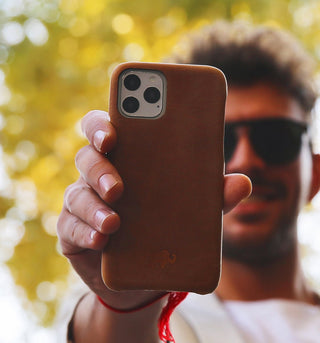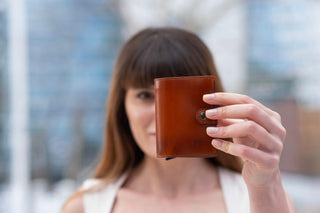Leather has played an important role in the evolution of humans and has been a part of our history for thousands of years. In fact, human civilization likely wouldn’t be where it is today if it weren’t for the discovery of leather -- the same could be said about fire, electricity, and vehicles.

Without leather, it’s unlikely that our ancestors would’ve had the resources to survive the extreme weather conditions and many outdoor elements we’re faced with on a daily basis. It has become one of the world’s most useful and innovative materials that were ever discovered.
With that being said, leather goods, the tanning methods that preserve them, and the use of leather in modern-day civilization are far different than that of ancient times. To ensure you understand the true history of leather, we’re going to explain it all in great detail below!
History of Leather Production in Ancient Times
The history of leather dates back thousands of years ago and had a variety of uses in a wide range of different civilizations. One of the most prominent uses of leather was to protect humans from the elements, but even this has evolved over time to include protection and luxury.
Ancient artifacts and wall paintings suggest that the Egyptians widely used leather for clothing, footwear, bottles, buckets, military equipment, and shrouds (coverings) when burying the dead. This dates back as far as 5,000 BC, which means the leather has been used for nearly 7,000 years.
It wasn’t until 500-400 BC that ancient civilizations started to develop ways of preserving leather for long-term use. These discoveries were attributed to ancient Greece, Egypt, and the Hebrew people. They utilized tree bark, leaves, and water in what we now refer to as vegetable tanning.
During these ancient times, the Egyptians, Greeks, Romans, and Hebrew people used leather for everything from clothes to footwear, military equipment, saddles, tools, harnesses, and much more. They would kill animals for food and use the hides as a by-product to produce leather.
Modern Day Leather Production
During the Middle Ages, leather production wasn’t just reserved for protection from elements. It started to become more of a luxury than a requirement in these civilizations, with many families utilizing leather for furniture, saddles, shoes, clothing, bags, and tacks for their horses.

In fact, many families used leather for dining room furniture since the material was easy to clean and didn’t absorb food odor. The uses of leather further evolved and developed during the 18th and 19th centuries, which was the period of industrialization and heavy machinery in America.
It wasn’t until the invention of the automobile that the tanning process started to evolve. People were in search of a much softer leather than what vegetable tanning could produce. That’s when chrome tanning was invented, which completely revolutionized the art of leather making.
Today, the leather industry relies on both vegetable tanning and chrome tanning, as well as oil tanning, when manufacturing leather.
Understanding the Leather Tanning Process
Tanning was invented thousands of years ago but has evolved over time. While most ancient civilizations utilized vegetable tanning, this was eventually replaced by chrome tanning and oil tanning in many situations. It’s what helps preserve and protect leather for long-term use.

Without tanned leather, our leather history likely wouldn’t be as robust as it is today. It not only involves altering the protein structure of the skin to limit the amount of decomposition but it can be used to give the leather a distinctive color -- outside of the normal brown leather we’re used to.
There are three major tanning processes used with leather making:
Vegetable Tanning
Uses vegetable matter (leaves, bark, twigs, roots) to dehydrate the animal skin with a compound called tannin. It replaces water molecules and bonds with the collagen in the skin. It’s a process that takes anywhere from 1-2 months to complete.
Chrome Tanning
The most popular tanning process replaces the use of vegetable tannins with a man-made compound called chromium sulfate. The end product is more flexible and is easier to dye. The process takes anywhere from one day to a few days.
Oil Tanning
When you see leather that’s referred to as ‘oil-tanned leather,’ it actually means it was chrome-tanned. The main difference is the addition and infusion of oils to make the leather a little more weather-resistant than its other leather counterparts.
In addition to those three tanning methods, there’s also something called combination tanning. It utilizes elements of all methods and is designed to give leather makers the best of all worlds. For example, some leather is mostly vegetable-tanned but then finished with chrome tanning.
What Animal Hides Are Used to Make Leather?
Now that we understand a little more about the leather history and the different tanning processes that make it what it is today, you’re likely curious as to what animals are utilized in the leather-making process. Well, the truth is leather comes from a wide range of different hides.
Before we go any further, let’s first understand that leather is a by-product. For the most part, animals aren’t killed for their skin. Instead, they’re killed for food (which most of us eat on a daily basis) and the skin (also known as hide) is used to make leather -- that way it isn’t wasted.
The majority of leather produced today (about 65%) comes from cows (cowhide). About 15% of leather comes from sheep, 11% comes from pigs, and 9% comes from goats. There are also several unique types of exotic leather that include snakeskin, alligator skin, and crocodile skin.
Are You Looking for Quality Leather Goods?
At Black Brook Case, there’s nothing we love more than quality and natural leather products. It’s what we live for and it’s what our entire company is built on. We have a wide range of leather goods available in our online shop and are extremely excited to share them with you today!
Whether you’re interested in a case for your phone, tablet, laptop, or AirPods, a band for your Apple Watch, bags, totes, office accessories, belts, shoes, purses, or wallets, Black Brook Case has you covered with premium full-grain leather -- the best of the best. Contact us today to learn more!








